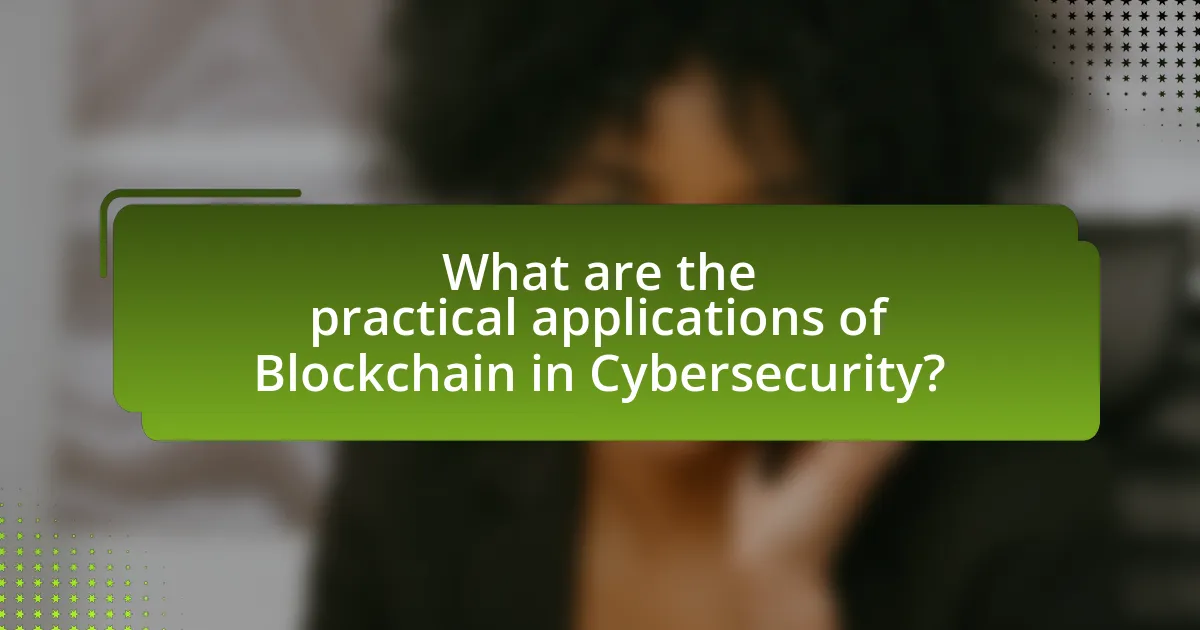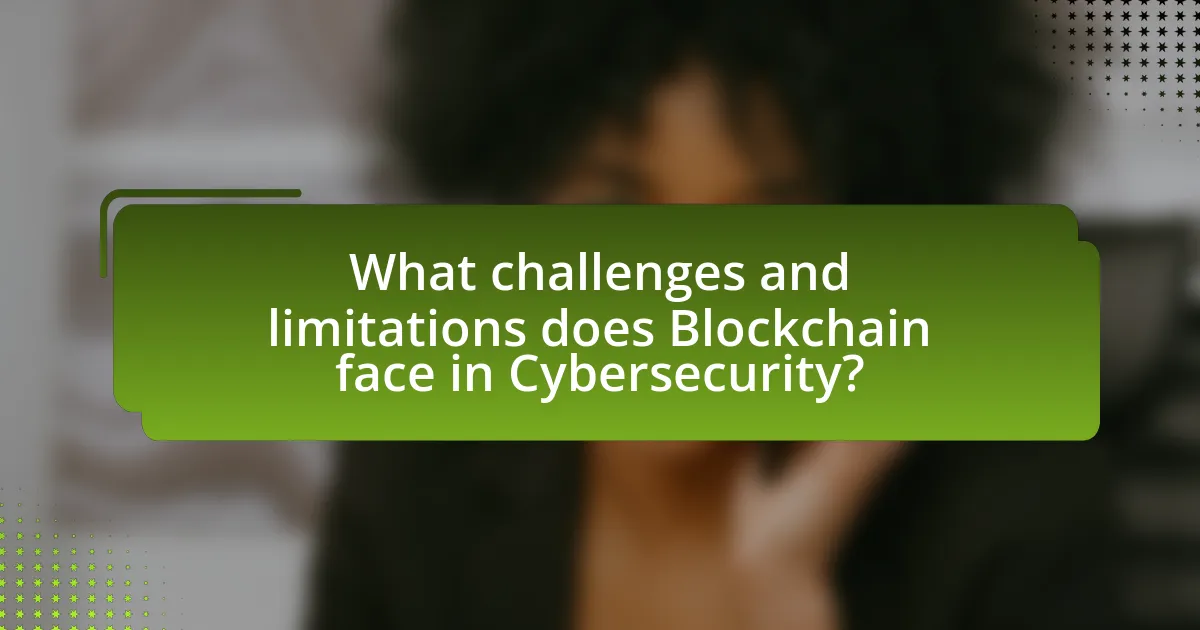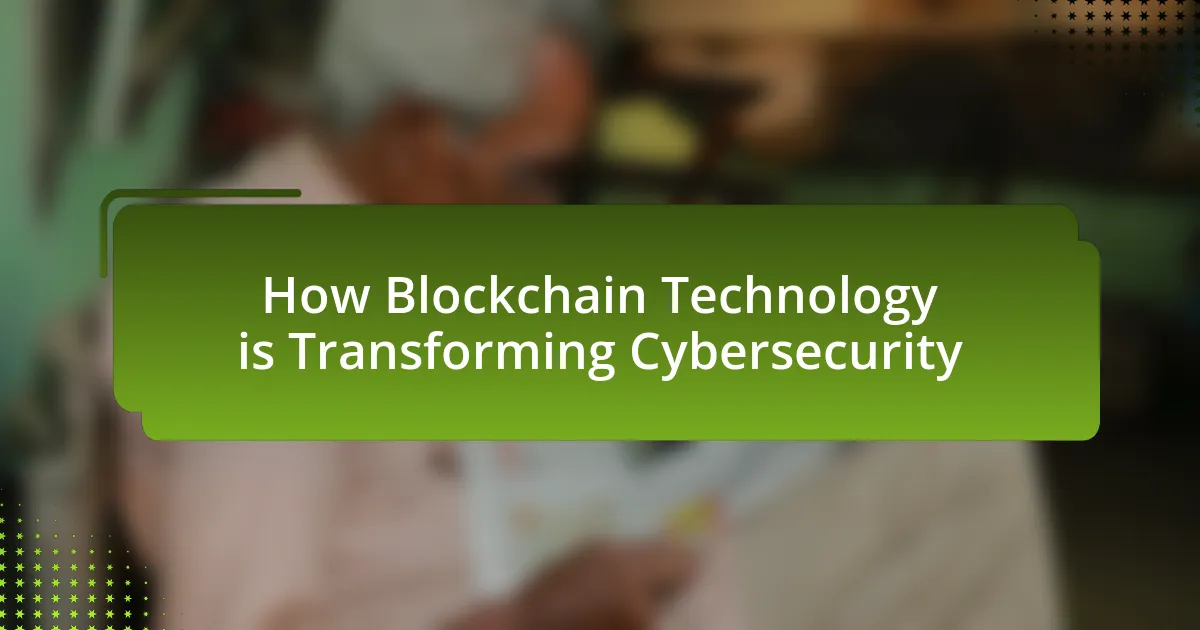Blockchain technology is fundamentally transforming cybersecurity by offering decentralized, tamper-proof data storage and enhanced transparency. This article explores the principles of blockchain, including decentralization, transparency, immutability, and security, and how they contribute to improved cybersecurity measures. It examines the unique advantages of blockchain in mitigating common cybersecurity threats, enhancing identity management, and securing IoT devices. Additionally, the article addresses the challenges and limitations of blockchain, such as scalability and regulatory compliance, while highlighting best practices for organizations looking to implement blockchain solutions effectively. Finally, it discusses future trends and emerging threats that blockchain may help mitigate in the cybersecurity landscape.

How is Blockchain Technology Revolutionizing Cybersecurity?
Blockchain technology is revolutionizing cybersecurity by providing decentralized, tamper-proof data storage and enhanced transparency. This decentralized nature reduces the risk of single points of failure, making it significantly harder for cyber attackers to compromise systems. For instance, blockchain’s cryptographic algorithms ensure that data integrity is maintained, as any unauthorized changes to the data would be immediately detectable by the network. Additionally, a report by the World Economic Forum highlights that blockchain can improve identity management and access control, further mitigating risks associated with data breaches. By enabling secure peer-to-peer transactions without intermediaries, blockchain enhances trust and accountability in digital interactions, fundamentally transforming how cybersecurity measures are implemented.
What are the fundamental principles of Blockchain Technology?
The fundamental principles of Blockchain Technology are decentralization, transparency, immutability, and security. Decentralization ensures that no single entity controls the entire network, which reduces the risk of manipulation and failure. Transparency allows all participants to view transaction histories, fostering trust among users. Immutability guarantees that once data is recorded on the blockchain, it cannot be altered or deleted, which enhances data integrity. Security is achieved through cryptographic techniques that protect data from unauthorized access and fraud. These principles collectively contribute to the reliability and effectiveness of blockchain in various applications, including enhancing cybersecurity measures.
How does decentralization enhance security in Blockchain?
Decentralization enhances security in blockchain by distributing data across a network of nodes, making it difficult for any single entity to manipulate or compromise the system. This distributed architecture reduces the risk of a single point of failure, as the integrity of the blockchain is maintained through consensus mechanisms that require agreement from multiple participants. For instance, in Bitcoin’s blockchain, the proof-of-work consensus algorithm ensures that altering any block would require an immense amount of computational power, making attacks economically unfeasible. Additionally, the transparency of transactions allows for real-time auditing, further bolstering security by enabling participants to verify the authenticity of data independently.
What role does cryptography play in Blockchain security?
Cryptography is fundamental to blockchain security as it ensures data integrity, confidentiality, and authenticity. By employing cryptographic techniques such as hashing and digital signatures, blockchain technology secures transactions against tampering and unauthorized access. For instance, each block in a blockchain contains a cryptographic hash of the previous block, creating a secure chain that is resistant to alterations. Additionally, digital signatures verify the identity of the sender, ensuring that only authorized users can initiate transactions. This reliance on cryptography not only protects sensitive information but also fosters trust among users, as evidenced by the widespread adoption of blockchain in various sectors, including finance and supply chain management.
Why is Cybersecurity a critical concern in today’s digital landscape?
Cybersecurity is a critical concern in today’s digital landscape due to the increasing frequency and sophistication of cyberattacks targeting individuals and organizations. In 2021, cybercrime was projected to cost the world $6 trillion annually, highlighting the financial and operational risks associated with inadequate cybersecurity measures. As more devices connect to the internet and sensitive data is stored online, the potential for breaches escalates, making robust cybersecurity essential for protecting personal information, maintaining business integrity, and ensuring national security.
What are the most common cybersecurity threats faced by organizations?
The most common cybersecurity threats faced by organizations include phishing attacks, ransomware, malware, insider threats, and denial-of-service (DoS) attacks. Phishing attacks, which involve deceptive emails to steal sensitive information, accounted for 90% of data breaches in 2020, according to the Verizon Data Breach Investigations Report. Ransomware, which encrypts data and demands payment for decryption, has increased by 150% in 2020, as reported by Cybersecurity Ventures. Malware, including viruses and spyware, poses significant risks by compromising systems and data integrity. Insider threats, stemming from employees or contractors, can lead to data leaks and sabotage, with the Ponemon Institute noting that the average cost of an insider threat incident is $11.45 million. Lastly, denial-of-service attacks disrupt services by overwhelming systems, with a 20% increase in frequency reported by the security firm Akamai in 2021.
How do traditional cybersecurity measures fall short?
Traditional cybersecurity measures fall short primarily due to their reliance on perimeter-based defenses, which are increasingly ineffective against sophisticated cyber threats. These measures often focus on preventing unauthorized access through firewalls and antivirus software, but they fail to address vulnerabilities within the network itself. For instance, a 2021 report by Cybersecurity Ventures indicated that ransomware attacks are projected to cost businesses $20 billion by 2021, highlighting the inadequacy of traditional defenses against evolving threats. Additionally, traditional measures often lack real-time threat detection and response capabilities, leaving organizations exposed to breaches that can go undetected for extended periods. This gap in security is further exacerbated by the growing complexity of IT environments, where multiple devices and cloud services create additional attack surfaces that traditional measures are ill-equipped to manage.
What unique advantages does Blockchain offer for Cybersecurity?
Blockchain offers unique advantages for cybersecurity through its decentralized architecture, which enhances data integrity and security. By distributing data across a network of nodes, blockchain minimizes the risk of a single point of failure, making it significantly harder for cyber attackers to manipulate or compromise the system. Additionally, the use of cryptographic hashing ensures that any alteration of data is easily detectable, providing a robust mechanism for maintaining data authenticity. According to a report by the World Economic Forum, blockchain technology can reduce the costs associated with data breaches by up to 30%, highlighting its potential to improve cybersecurity measures effectively.
How does Blockchain improve data integrity and authenticity?
Blockchain improves data integrity and authenticity by utilizing a decentralized ledger that records transactions in a secure and immutable manner. Each transaction is cryptographically linked to the previous one, creating a chain that is resistant to tampering. This structure ensures that once data is recorded, it cannot be altered without consensus from the network, thereby maintaining its integrity. Additionally, the use of public and private keys in blockchain technology allows for secure verification of identities, ensuring that the data originates from a legitimate source. Studies have shown that blockchain can reduce data breaches and fraud, as evidenced by a report from IBM which states that organizations using blockchain technology experience 50% fewer data breaches compared to those that do not.
In what ways does Blockchain facilitate secure transactions?
Blockchain facilitates secure transactions through its decentralized and immutable ledger system. Each transaction is recorded in a block and linked to the previous block, creating a chain that is resistant to tampering. This structure ensures that once a transaction is added, it cannot be altered without consensus from the network, which enhances security. Additionally, blockchain employs cryptographic techniques to secure transaction data, making it difficult for unauthorized parties to access or manipulate information. The transparency of the blockchain allows all participants to verify transactions independently, further reducing the risk of fraud. According to a report by the World Economic Forum, blockchain technology can reduce fraud by up to 80% in certain applications, demonstrating its effectiveness in securing transactions.

What are the practical applications of Blockchain in Cybersecurity?
Blockchain technology has several practical applications in cybersecurity, primarily enhancing data integrity, authentication, and secure transactions. By utilizing decentralized ledgers, blockchain ensures that data cannot be altered without consensus from all parties involved, significantly reducing the risk of data tampering and unauthorized access. For instance, in identity management, blockchain can securely store and verify user identities, minimizing the chances of identity theft. Additionally, smart contracts on blockchain can automate and enforce security protocols, ensuring compliance and reducing human error. According to a report by IBM, 77% of organizations believe that blockchain can enhance their cybersecurity posture by providing a more secure framework for data sharing and transactions.
How is Blockchain being used in identity management?
Blockchain is being used in identity management by providing a decentralized and secure method for verifying identities. This technology enables individuals to control their personal data, reducing the risk of identity theft and fraud. For instance, blockchain allows for the creation of self-sovereign identities, where users can manage their credentials without relying on a central authority. A notable example is the use of blockchain in the ID2020 Alliance, which aims to provide digital identities to underserved populations, demonstrating the practical application of blockchain in enhancing identity verification processes.
What are the benefits of using Blockchain for identity verification?
The benefits of using Blockchain for identity verification include enhanced security, increased transparency, and improved efficiency. Blockchain technology provides a decentralized and immutable ledger, which significantly reduces the risk of identity theft and fraud by ensuring that identity data cannot be altered without consensus. According to a report by the World Economic Forum, blockchain can reduce identity fraud by up to 80% due to its cryptographic security features. Additionally, the transparency of blockchain allows for real-time verification of identities, streamlining processes that traditionally require extensive documentation and manual checks. This efficiency can lead to cost savings and faster service delivery in identity verification processes.
How does Blockchain prevent identity theft?
Blockchain prevents identity theft by utilizing decentralized and immutable ledgers that securely store user information. Each transaction or identity verification is recorded in a block that is linked to previous blocks, making it nearly impossible to alter or delete data without consensus from the network. This structure ensures that personal data is not stored in a single location, reducing the risk of centralized data breaches. Additionally, cryptographic techniques used in blockchain, such as hashing and public-private key encryption, further protect user identities by ensuring that only authorized parties can access sensitive information. The combination of decentralization and cryptography creates a robust defense against identity theft, as evidenced by the increasing adoption of blockchain in identity management solutions across various sectors.
What role does Blockchain play in securing IoT devices?
Blockchain plays a critical role in securing IoT devices by providing a decentralized and tamper-resistant framework for data integrity and authentication. This technology enables secure communication between devices by ensuring that data transmitted is immutable and verifiable, reducing the risk of unauthorized access and data breaches. For instance, a study published in the journal “IEEE Internet of Things” highlights that blockchain can enhance the security of IoT networks by enabling devices to authenticate each other without relying on a central authority, thus mitigating single points of failure.
How does Blockchain enhance the security of IoT networks?
Blockchain enhances the security of IoT networks by providing a decentralized and immutable ledger that ensures data integrity and authenticity. This technology allows devices within an IoT network to communicate securely without relying on a central authority, reducing the risk of single points of failure and potential cyberattacks. Each transaction or data exchange is recorded in a block that is cryptographically linked to previous blocks, making it nearly impossible for malicious actors to alter the data without detection. Furthermore, the use of smart contracts can automate security protocols, ensuring that only authorized devices can access or interact with the network. Studies have shown that integrating blockchain with IoT can significantly reduce vulnerabilities, as evidenced by research from the IEEE, which highlights the effectiveness of blockchain in mitigating risks associated with IoT devices.
What challenges does Blockchain address in IoT cybersecurity?
Blockchain addresses several critical challenges in IoT cybersecurity, including data integrity, device authentication, and secure communication. By utilizing a decentralized ledger, blockchain ensures that data transmitted between IoT devices remains tamper-proof, thereby maintaining its integrity. Additionally, blockchain facilitates robust device authentication through cryptographic keys, which helps prevent unauthorized access and ensures that only legitimate devices can communicate within the network. Furthermore, the technology enables secure communication channels by encrypting data and providing a transparent audit trail, which enhances accountability and traceability in IoT ecosystems. These features collectively mitigate risks associated with cyberattacks, such as data breaches and unauthorized device manipulation.
How can Blockchain assist in threat detection and response?
Blockchain can assist in threat detection and response by providing a decentralized and immutable ledger that enhances data integrity and transparency. This technology enables real-time monitoring of network activities, allowing for the identification of anomalies that may indicate security threats. For instance, the use of smart contracts can automate responses to detected threats, ensuring swift action without human intervention. Additionally, blockchain’s cryptographic features secure data against tampering, making it easier to trace the origin of security breaches. Studies have shown that organizations implementing blockchain for cybersecurity have reported a significant reduction in data breaches, highlighting its effectiveness in enhancing threat detection and response mechanisms.
What are the mechanisms for real-time threat monitoring using Blockchain?
Real-time threat monitoring using Blockchain involves mechanisms such as decentralized data storage, immutable logging, and smart contracts. Decentralized data storage allows for the distribution of threat data across multiple nodes, reducing the risk of single points of failure and enhancing data integrity. Immutable logging ensures that once threat data is recorded on the Blockchain, it cannot be altered or deleted, providing a reliable audit trail for security incidents. Smart contracts automate responses to detected threats, enabling immediate action without human intervention. These mechanisms collectively enhance the speed and reliability of threat detection and response, as evidenced by studies showing that Blockchain can reduce incident response times by up to 50%.
How does Blockchain improve incident response times?
Blockchain improves incident response times by providing a decentralized and immutable ledger that enhances data integrity and transparency. This technology allows for real-time sharing of incident data among stakeholders, which accelerates the identification and resolution of security breaches. For instance, a study by the University of Cambridge found that organizations utilizing blockchain for incident management reported a 30% reduction in response times due to improved collaboration and data accuracy. By ensuring that all parties have access to the same verified information, blockchain minimizes delays caused by misinformation or lack of communication, thereby streamlining the overall incident response process.

What challenges and limitations does Blockchain face in Cybersecurity?
Blockchain faces several challenges and limitations in cybersecurity, primarily including scalability issues, regulatory uncertainty, and the potential for smart contract vulnerabilities. Scalability is a significant concern as many blockchain networks struggle to process a high volume of transactions quickly, which can lead to delays and increased costs. For example, Bitcoin can handle approximately seven transactions per second, while traditional payment systems like Visa can process thousands. Regulatory uncertainty arises because the legal status of blockchain technology varies by jurisdiction, complicating compliance for businesses. Additionally, smart contracts, which automate processes on the blockchain, can contain coding errors or vulnerabilities that hackers can exploit, leading to significant financial losses. These challenges highlight the need for ongoing research and development to enhance blockchain’s effectiveness in cybersecurity.
What are the scalability issues associated with Blockchain technology?
Scalability issues associated with Blockchain technology primarily stem from its limited transaction throughput and high latency. For instance, Bitcoin processes approximately 7 transactions per second, while Ethereum handles around 30 transactions per second, which is significantly lower than traditional payment systems like Visa that can process over 24,000 transactions per second. This limitation arises from the consensus mechanisms used, such as Proof of Work, which require substantial computational resources and time to validate transactions. Additionally, as the number of users and transactions increases, the size of the blockchain grows, leading to longer synchronization times and increased storage requirements for nodes. These factors collectively hinder the ability of blockchain networks to scale effectively while maintaining decentralization and security.
How do transaction speeds impact Blockchain’s effectiveness in Cybersecurity?
Transaction speeds significantly impact Blockchain’s effectiveness in Cybersecurity by determining how quickly data can be verified and recorded, which is crucial for real-time threat detection and response. Faster transaction speeds enable quicker validation of transactions, allowing for timely updates to security protocols and immediate action against potential threats. For instance, blockchain networks like Solana can process thousands of transactions per second, enhancing their ability to secure data against cyber threats effectively. In contrast, slower networks may hinder the responsiveness required to combat fast-evolving cyber threats, thereby reducing overall security effectiveness.
What solutions exist to overcome scalability challenges?
To overcome scalability challenges in blockchain technology, solutions include sharding, layer 2 protocols, and consensus mechanism improvements. Sharding divides the blockchain into smaller, manageable pieces, allowing parallel processing of transactions, which significantly increases throughput. Layer 2 protocols, such as the Lightning Network for Bitcoin, enable off-chain transactions that reduce the load on the main blockchain, enhancing speed and efficiency. Additionally, advancements in consensus mechanisms, like Proof of Stake, offer faster transaction validation compared to traditional Proof of Work, thereby improving scalability. These methods collectively address the limitations of blockchain scalability, facilitating broader adoption in cybersecurity applications.
What regulatory and compliance challenges does Blockchain encounter?
Blockchain encounters significant regulatory and compliance challenges primarily due to its decentralized nature, which complicates the enforcement of existing laws. Regulatory bodies struggle to classify blockchain transactions, leading to uncertainty in areas such as taxation, anti-money laundering (AML), and consumer protection. For instance, the Financial Action Task Force (FATF) has issued guidelines that require cryptocurrency exchanges to comply with AML regulations, yet many jurisdictions lack clear frameworks for enforcement. Additionally, the anonymity provided by blockchain can hinder compliance with Know Your Customer (KYC) regulations, making it difficult for institutions to verify user identities. These challenges create a complex landscape for businesses operating in the blockchain space, as they must navigate varying regulations across different countries and regions.
How do data privacy laws affect Blockchain implementation?
Data privacy laws significantly impact blockchain implementation by imposing restrictions on how personal data can be collected, stored, and processed. For instance, regulations like the General Data Protection Regulation (GDPR) in the European Union require that individuals have the right to access their data and request its deletion, which conflicts with blockchain’s immutable nature. This creates challenges for organizations looking to leverage blockchain technology while ensuring compliance with such laws, as they must find ways to balance transparency and data protection. Additionally, the requirement for data minimization under privacy laws necessitates careful consideration of what data is recorded on the blockchain, potentially limiting its use in certain applications.
What are the implications of cross-border data regulations on Blockchain?
Cross-border data regulations significantly impact blockchain technology by imposing restrictions on data transfer and storage across national boundaries. These regulations, such as the General Data Protection Regulation (GDPR) in Europe, require that personal data be processed and stored in compliance with local laws, which can conflict with blockchain’s decentralized and immutable nature. For instance, the GDPR mandates the right to be forgotten, which contradicts blockchain’s permanent record-keeping. Additionally, compliance with varying regulations across jurisdictions can lead to increased operational costs and complexity for blockchain networks, as they must implement mechanisms to ensure data handling aligns with diverse legal frameworks. This regulatory landscape can hinder the global scalability of blockchain applications, as organizations may face legal uncertainties and potential penalties for non-compliance.
How can organizations effectively implement Blockchain for Cybersecurity?
Organizations can effectively implement Blockchain for Cybersecurity by integrating decentralized ledger technology to enhance data integrity and security. This involves utilizing Blockchain’s immutable records to create tamper-proof logs of transactions and access events, which significantly reduces the risk of data breaches. For instance, a study by the World Economic Forum highlights that Blockchain can improve identity management and authentication processes, thereby mitigating unauthorized access. Additionally, organizations can deploy smart contracts to automate security protocols, ensuring compliance and reducing human error. By leveraging these features, organizations can create a more resilient cybersecurity framework that is less susceptible to attacks.
What best practices should organizations follow when adopting Blockchain?
Organizations should follow best practices such as conducting thorough research, defining clear use cases, ensuring regulatory compliance, and investing in training when adopting Blockchain. Conducting thorough research helps organizations understand the technology’s capabilities and limitations, which is crucial for effective implementation. Defining clear use cases allows organizations to focus on specific problems that Blockchain can solve, enhancing the likelihood of successful outcomes. Ensuring regulatory compliance is essential, as it mitigates legal risks associated with Blockchain applications, particularly in sectors like finance and healthcare. Investing in training equips employees with the necessary skills to leverage Blockchain technology effectively, fostering a culture of innovation and security. These practices are supported by industry reports indicating that organizations that prioritize these areas experience higher success rates in Blockchain adoption.
How can organizations measure the effectiveness of Blockchain in enhancing Cybersecurity?
Organizations can measure the effectiveness of Blockchain in enhancing Cybersecurity by evaluating key performance indicators (KPIs) such as incident response time, data integrity, and the frequency of security breaches. For instance, a study by the International Journal of Information Management found that organizations implementing Blockchain technology reported a 30% reduction in data tampering incidents, demonstrating its impact on data integrity. Additionally, organizations can assess the speed of incident response by comparing pre- and post-Blockchain implementation metrics, which often show improved response times due to the decentralized nature of Blockchain that facilitates quicker access to secure data. These metrics provide concrete evidence of Blockchain’s effectiveness in enhancing Cybersecurity.
What future trends can we expect in Blockchain and Cybersecurity?
Future trends in Blockchain and Cybersecurity include increased adoption of decentralized identity solutions, enhanced data integrity through immutable ledgers, and the integration of smart contracts for automated security protocols. Decentralized identity solutions will empower users to control their personal data, reducing the risk of identity theft. Immutable ledgers will ensure that data remains unaltered, which is crucial for compliance and audit trails. The use of smart contracts will automate security measures, allowing for real-time responses to threats. According to a report by Gartner, by 2025, 30% of organizations will use blockchain for secure identity management, highlighting the growing intersection of these technologies.
How will advancements in Blockchain technology shape the future of Cybersecurity?
Advancements in Blockchain technology will significantly enhance Cybersecurity by providing decentralized and immutable data storage solutions. This decentralization reduces the risk of single points of failure, making it harder for cyber attackers to compromise entire systems. For instance, the use of blockchain for identity verification can prevent unauthorized access, as it allows for secure, tamper-proof records of user identities. Additionally, smart contracts can automate security protocols, ensuring that transactions are executed only when predefined conditions are met, thereby minimizing human error and potential vulnerabilities. According to a report by the World Economic Forum, blockchain technology can reduce fraud in digital transactions by up to 80%, demonstrating its potential to transform Cybersecurity practices.
What emerging threats might Blockchain help mitigate in the future?
Blockchain technology may help mitigate emerging threats such as data breaches, identity theft, and fraud in the future. By providing a decentralized and immutable ledger, blockchain enhances data integrity and security, making it difficult for unauthorized parties to alter or access sensitive information. For instance, a study by the World Economic Forum highlights that blockchain can reduce the risk of data tampering and enhance transparency in transactions, which is crucial in combating fraud. Additionally, blockchain’s ability to enable secure digital identities can significantly lower the incidence of identity theft, as it allows individuals to control their personal data without relying on centralized databases that are vulnerable to attacks.



